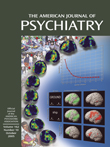Risperidone-Induced Immunoallergic Hepatitis
Mr. A, a 28-year-old Caucasian man with paranoid schizophrenia, was administered risperidone (titrated up to 8 mg/day within 5 weeks) because of a reappearance of auditory hallucinations and thought disorder after he had been free of all medications for 12 months.After 7 weeks of outpatient risperidone monotherapy, elevated levels of serum aspartate aminotransferase (AST) (83 U/liter, normal=10–50) and alanine aminotransferase (ALT) (123 U/liter, normal=10–60) were observed. The results of cholestatic blood measurements, WBC and RBC counts, and coagulation tests were normal. Mr. A’s medical history did not reveal autoimmune or allergic disease. There was no history of alcohol or substance abuse, except occasional hashish smoking. During Mr. A’s previous hospitalization (4 years earlier), while he was receiving haloperidol, his serum transaminase levels had been normal.His ALT and AST levels markedly increased during the 8th week of treatment (AST=139 U/liter, ALT=522 U/liter). Mr. A developed nausea, vomiting, and epigastric pain. Hospitalization was decided upon, and risperidone treatment was discontinued.An abdominal ultrasound was normal. Serological markers for viral hepatitis A, B, and C were negative. Determinations of ceruloplasmin and copper in his serum were also normal. His WBC count showed eosinophilia (850 cells/mm3, normal<500), and laboratory analyses for autoimmune diseases revealed high levels of anti-smooth-muscle antibodies (titer=1:640), without actin or vimentin specificity. Tests for anti-liver-kidney microsomal enzymes, antisoluble liver antigen, and antinuclear and antimitochondrial auto-antibodies were negative.With treatment consisting only of loxapine (200 mg/day) and oxazepam (200 mg/day), Mr. A’s AST and ALT levels returned to normal within 3 weeks. One month after risperidone discontinuation, his anti-smooth-muscle antibodies titer had decreased to 1:100, and his eosinophil level had returned to normal. Mr. A was then given haloperidol (20 mg/day), and his serum transaminase levels remained normal.
References
Information & Authors
Information
Published In
History
Authors
Metrics & Citations
Metrics
Citations
Export Citations
If you have the appropriate software installed, you can download article citation data to the citation manager of your choice. Simply select your manager software from the list below and click Download.
For more information or tips please see 'Downloading to a citation manager' in the Help menu.
View Options
View options
PDF/EPUB
View PDF/EPUBGet Access
Login options
Already a subscriber? Access your subscription through your login credentials or your institution for full access to this article.
Personal login Institutional Login Open Athens loginNot a subscriber?
PsychiatryOnline subscription options offer access to the DSM-5-TR® library, books, journals, CME, and patient resources. This all-in-one virtual library provides psychiatrists and mental health professionals with key resources for diagnosis, treatment, research, and professional development.
Need more help? PsychiatryOnline Customer Service may be reached by emailing [email protected] or by calling 800-368-5777 (in the U.S.) or 703-907-7322 (outside the U.S.).

